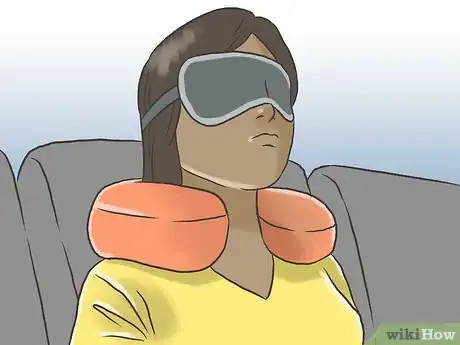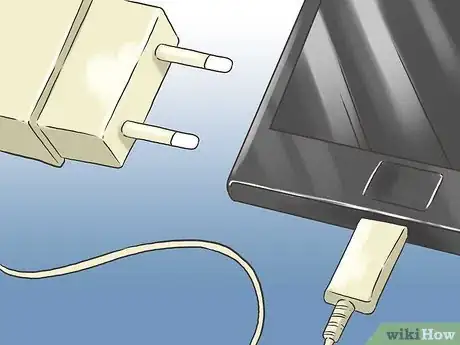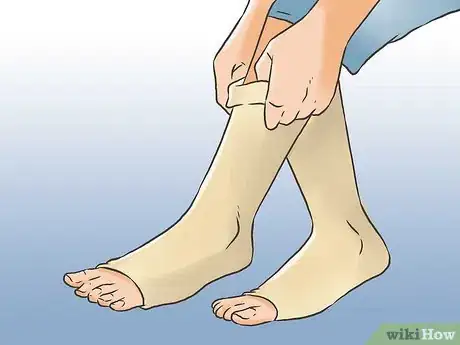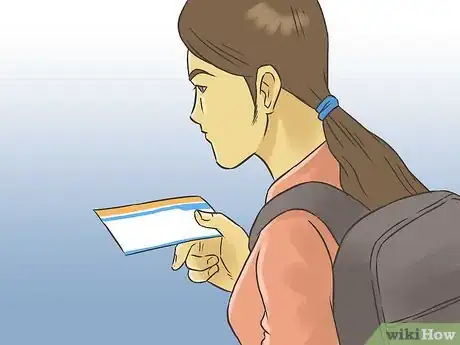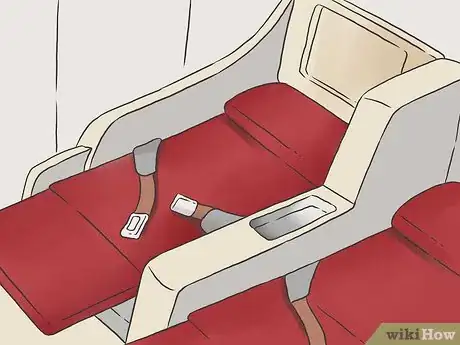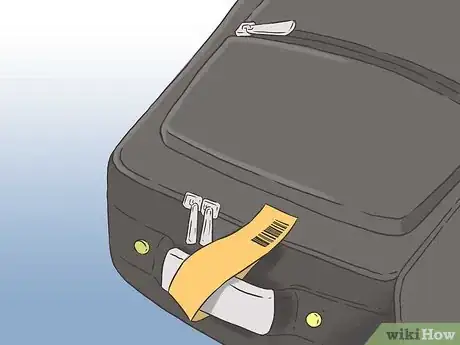This article was co-authored by Angela Rice. Angela Rice is a Luxury Travel Specialist and Co-Founder of Boutique Travel Advisors, a luxury travel advising business in Phoenix, Arizona. Angela specializes in consulting and curating highly customized and unique travel itineraries for clients seeking luxury, group, and multi-generational family travel. Angela studied at Arizona State University and The University of Iowa Tippie College of Business. She has prior consulting experience in accounting and business, which helps her run her business behind the scenes. Angela has been featured in The Washington Post, Reader's Digest, Travel Weekly, USA Today, Travel Market Report, Phoenix Magazine, and MSN. She is also a frequent guest on WBBM News Radio 105.9 FM's Travel Tuesday show.
There are 16 references cited in this article, which can be found at the bottom of the page.
wikiHow marks an article as reader-approved once it receives enough positive feedback. This article has 17 testimonials from our readers, earning it our reader-approved status.
This article has been viewed 624,816 times.
Long haul flights require more preparation than short flights, especially if you're leaving for a while or going overseas. Preparation is the key to enjoying both a comfortable flying experience and to ensure that you arrive at your destination with everything needed, as well as knowing you've left your life back home in good hands. Along with a good sense of humor and some stamina, not only will good preparation help you to ease into a rhythm from the moment you leave your house to getting through airport lines and enduring the long flight, but the more ways you have prepared to occupy yourself, the better!
Steps
Preparing for Comfort
-
1Take a blanket and pillow. Taking your own soft blanket and pillow or neck pillow can really make your flight much more comfortable. Though some airlines offer tiny flat pillows and itchy blankets, you may be better off taking your own. You can find sets of pillows and blankets that are surprisingly compact and which aren't a huge pain to carry. In a pinch, you can even buy them near the terminal, so you don't have to take them through security, though this will likely be more costly.
- If you have your blanket and pillow, you won't have to worry about staying warm or getting a stiff neck.
-
2Take sanitary wipes.[1] These can help you keep your hands sanitised and clean up your tray table. You don't want to have a dirty or sticky tray table after your first meal, or it will be a pain for the duration of the flight. Having sanitary/anti-bacterial wipes on hand will also keep you from having to get up and wash your hands every time you eat something.Advertisement
-
3Take an eye mask.[2] Though some airlines provide these, especially for long flights, there are no guarantees. Having an eye mask will help you doze off and to rest your eyes. Though the lights in a plane will dim on an overnight flight, you may still want some extra protection for your eyes.
-
4Take ear plugs or noise-cancelling headphones.[3] These can also help you drown out the sounds on the plane when you try to rest. You may get stuck near a crying child or two people who talk incessantly, and you want to protect yourself against that just in case. Again, some planes may offer ear plugs, but it's best not to count on it. Noise-cancelling headphones, while a lot bigger than ear plugs, can really make the world around you feel silent, and bring you peace and tranquility.
- Listening to music on any suitable personal device you may have brought with headphones, can also help you drown out the noise around you.
-
5Wear and take comfortable clothes. Think comfort over international jet-setting model. Seriously, don't wear stiff, tight or itchy clothing – you'll soon regret it if you do. Wear loose clothing that is easily cleaned. Avoid synthetic materials that overheat and expensive labels which can draw unwanted attention. Avoid unnecessary clothing like jewelry, belts and boots that will slow you down through security checkpoints and are potential pickpocket attractants in some destinations. Remember that the fewer valuables you bring; the less you have to worry about.[4] Here are some tips for clothes to bring to make your long flight more bearable:
- Take clothes that will keep you warm in case the plane gets cold. Some flights can get pretty chilly, so make sure you take a fleece or sweater, a scarf, or maybe even a knit hat to keep you warm in case that happens.
- Wear layers. Make sure you have a tank top or t-shirt under the long-sleeved shirt or sweater you're wearing. Planes can also get really hot around take off and landing, and you don't want to be stuck in a heavy shirt with nothing underneath.
- Take warm socks. Socks can help keep your feet warm if you're wearing sandals, and they can also be a great substitute for shoes so your feet are comfortable on your flight.
- Instead of stiff pants or jeans, wear leggings, sweatpants, compression socks, warm boots, a light, soft, scarf, or loose pants to keep you comfortable.
- If you're getting off the plane and heading straight out to explore the city where you're staying, then take a change of clothes with you in your carry-on luggage.
- Silk long underwear is lightweight, takes up no room, and is great if you are going to a colder climate and don't want to buy an entire wardrobe for it. Ditto for a black cashmere sweater.
-
6Take a travel toothbrush and toothpaste, or just small versions of these.[5] If you're the kind of person who needs to brush their teeth after every meal or if you just want to avoid that gross; "haven't-brushed-my-teeth-in-a-while" feeling in your mouth, then you may be well served by taking a small toothbrush and toothpaste on the flight. Though it won't be super easy to brush your teeth in the tiny airplane bathroom, it's better than having a mossy mouth.
- Note that the TSA association limits liquids, gels, and aerosols to 3.4oz./100.55ml. per container; and up to 1 quart for each hand carry luggage.
-
7Take chewing gum.[6] You can also take some gum to make your breath fresher, if this is easier. This will not only refresh your breath, but you can also chew gum when the plane takes off and lands to avoid having your ears pop due to the rapid change in pressure.
Preparing for Entertainment
-
1Decide on what in-flight electronic entertainment you'll use. There are two approaches to this. One is to leave it all up to the airline (be sure to check what they offer first) and travel as light as possible. The other is to take your own entertainment items because you don't trust that the airline's offerings are adequate. Just be aware that there are weight restrictions and that the more things you take with you, the more things you have to worry about losing, breaking or having stolen. It also means less room in your bags for bringing back souvenirs and treats from wherever you're traveling to.[7]
- On the other hand, some items will be handy during the trip itself and not just on the plane (for example an MP3 Player or an eReader), so letting them do double duty is great.
- The other thing to consider is that, if you want to pay for a movie or on-flight entertainment, it can be quite expensive. Though it's complimentary on some flights, you should look into the policy of the airline you're taking. You may be better off renting a movie on iTunes or Google Play and watching it on your Tablet or computer (though the volume may be a bit lower than it would be on the plane's movies) for 3-4 dollars a pop than paying 10 dollars or more to watch a movie on the plane. Also, if you select your movies in advance, you'll have more options to choose from.
-
2Take your electronics. The things you might consider carrying on the plane include an MP3 Player for music and audio books, a laptop or Tablet for writing and reading (and surfing on your trip), a portable DVD player (although this will be quite bulky and your hotel rooms in many places have DVD players) or a portable gaming console such as a Nintendo 3DS, a PSVita or a Nintendo Switch.[8] All three have pros and cons that you need to weigh. If you're going on vacation, however, you may want to leave your laptop or other things that remind you of work at home.
- Take your cell phone; you may need it on the trip and even if it cannot be used on the plane, it should be with you for safekeeping. Keep in mind that many newer planes have in-flight entertainment available.
- And if you take a laptop or Tablet, make sure to have fully charged it before leaving. Depending on the length of the flight, you may wish to consider investing in a portable battery pack to keep all of your electronics fully charged if there are no power points available on the plane.
-
3Take reading material. If you haven't read that novel yet or caught up on the news, here's your chance. Don't forget that you can also stock up on the latest magazines in the airport before boarding the plane and if you manage to read them on the flight, you don't need to cart them with you off the flight! If you have an eReader, you might like to take it as it can store hundreds of novels or other reading material, including guidebook information for your destination. Here are some forms of reading material you can take:
- Novels (take more than one in case your book gets boring)
- Celebrity gossip magazines, such as Us Weekly
- Reputable magazines, such as The New Yorker, The Economist, or TIME
- The newspaper
- Materials to read for school or work
- If you like to write, you can also take writing material, such as a journal, a laptop, or an article you're preparing. This can be the perfect time to write.
-
4Take games. Whether you're traveling with friends or hoping to make friends with someone sitting next to you, taking along some games is a great way to keep yourself entertained. You can take dice, cards, or travel-sized versions of games like Sorry! , "Monopoly Deal" or even magnetic chess or checkers. If you're traveling with someone, make sure it's a game that they would want to play in advance.
- You can also take a notepad so you can play games like MASH or Hangman with another person.
- You can also come prepared with some simple games that only require you to talk. For example, you can play "Geography": all you do is say the name of a country or city; after that, your partner has to say the name of a country or city that starts with the last letter of the country or city you said; then you have to do the same, and you go back and forth until one of you can't think of anything to say or repeats a country or city that was already said.
- You can also take a book of Mad Libs to keep you and your friend or seat mate entertained.
-
5Take puzzles. Another way to keep yourself entertained, especially if you're by yourself, is to take a book of crossword puzzles, Sudoku, or other word or number puzzles. This way, you can just dip into the puzzle whenever you want and feel the time flying by. Just one medium-level crossword could take two or more hours to complete, and you'll see the time whizzing by as you get to work.
- You can also take a book of MENSA brain teasers, which will be a combination of word puzzles, number puzzles, and other tricky challenges.
-
6Charge all of your electronics before your flight.[9] This is important if you want to use them to stay entertained during your long trip. Though you may get lucky and sit in an aisle that has an outlet, this isn't too likely. You should also be sure to put the charger in your carry-on bag! It's awfully easy to leave the charger at home and spoil your vacation with lamentations about leaving it behind. Ditto for international Sim card, phone cards or portable broadband USB connectors.
- If you're really desperate to charge one of your electronic devices, one of the flight attendants may do this for you in the back of the plane, but don't count on it.
- Many airlines today allow you to charge in flight. Look on seatguru.com and look up the different options available to you.
Staying Healthy on the Plane
-
1Bring healthy snacks. Snacks do break up the monotony of the flight as well as help stave off any unexpected hunger in between airline meals. If you're on a restricted diet or just want to snack without paying $5 for a tiny bag of Pop Chips or Chex Mix, then taking your own snacks is the way to go. This will also make it a bit easier for you to eat whenever you want, instead of waiting for the flight attendants to come around. Here are some snacks that won't spoil and will leave you feeling satiated while giving you a boost of energy:[10]
- Apples
- Trail mix
- Almonds, cashews, or pistachios (Make sure no one in the vicinity has aerial allergies)
- A granola bar (as long as it doesn't crumble too much)
- Yogurt-covered raisins
- Pretzels
- Dried mango or bananas
-
2Prepare to drink a lot of water. Airline travel is dehydrating, so stick to drinking water and plenty of it. Though you can't take a bottle of water past security, you can buy one near the terminal before you board your flight. You should also accept any chance you get to get a cup of water, because you don't know the next time the stewardess can come around. Of course, you can usually ask for water at the back of the plane or even by pushing the "call" button, but it's easier to simply accept the water when it comes your way.[11]
- Of course, while it's very important to drink water, you also don't want to be running to the bathroom every five minutes to pee, especially if you have a window seat and are worried about inconveniencing the people in your row. Find a balance between staying hydrated and not having your bladder feel full the whole time. Keep in mind that it's more important, though, to be hydrated with a full bladder than to be dehydrated and not have to pee.
-
3Take eye drops if your eyes tend to get dry. Eye drops help prevent your eyes from drying out in flight. Though they aren't mandatory, they really can help you if you experience the dry eyes that many people have during a flight. It can be pretty uncomfortable if you realize that your eyes are getting dry in the first hour of a ten-hour flight and there's nothing you can do about it.[12]
- Just make sure that your container of eye drops is small enough that you can take it on the plane and make it through security with it without a problem.
-
4Stay active on the plane. According to the National Institutes of Health, there is a small risk of developing deep vein thrombosis (DVT) on flights longer than four hours. Staying active will help prevent this from happening. You should try to walk up and down the aisles of the plane as much as you can, move, flex, and stretch your legs to keep your blood flowing, and wear clothing that is loose and comfortable. Here are some other things you can do:[13]
- Hydrate the day before the flight and during the flight
- Wear compression stockings to keep your legs from swelling if you're at risk (talk to your doctor about risk factors)
- Avoid alcohol the night before or during the flight because it will dehydrate you. The same goes for coffee, soft drinks, and chocolate.
- Take baby aspirin the night before and the day of your flight if you don't have any problems with ulcers.
- Try to get an aisle seat so you can easily walk around the plane.
-
5Take any medication that you may need. Take anti-nausea medication, pain relief medication, sleep aids, or any of the regular medication that you take on the plane with you so you don't find yourself in need of medication in the middle of your flight. Make sure to take your regular medication as well as any medication you typically use for pain relief in case you get a headache, neck ache, or experience another pain. Make sure you Take ALL medications in their original packaging. You may need to show your prescription for some medications prior to some international flights.
- If you're thinking of taking a sleep aid to help you sleep on an overnight flight, make sure you try it out in advance. You don't want to try it for the first time on your flight and then end up having a miserable experience on your flight and after you land.
Making the Most Convenient Flight Arrangements
-
1Decide which airline to fly. Obviously, you need to know the available flights for your destination and the price has to be "right". However, other things you should be considering when booking for a long haul flight is just how comfortable that airline will prove to be. Some airlines do offer more legroom than others on particular sectors and this is an important consideration the longer the flight gets; do some research and read the advertising promises, as well as checking out people's opinions in online travel and flight forums.[14]
- Check out what entertainment is offered by the airline. Many newer aircraft types offer individualized monitors in the back of the seat right in front of you, so that you don't have to crane your neck to try to see a wobbly old movie screen with someone else's head in front of it.
- A lot of these individual entertainment centers now come with lots of movies, news, documentary, etc. choices, as well as radio, music and games that can be played using a handheld device that lifts out from the seat.
-
2Choose a comfortable seat in advance.[15] Though somebody's got to be stuck in that middle seat, you should do what you can to get the seat you want. First, you should figure out which seat you prefer, the aisle or the window. The aisle may be the most comfortable for a long flight because you have a bit more room on the side facing the aisle and can easily get up and stretch your legs or use the restroom without inconveniencing people; however, some people like the window because it's easier to rest against it, and because it can be pleasant to look outside. Whatever you choose, here are some tips for picking your seat:[16]
- Most airlines allow you to choose your seat when you book your flight. Don't overlook this important aspect of booking the flight, even if you're in a rush.
- If you didn't choose a seat online, try to choose it when you check in, or even at the gate of the flight. Though your flight might be full and you may not be able to switch your seat, it's worth trying.
- You can try to sit toward the front of the plane so you get to board earlier and leave the plane earlier. The downside is that you may be further from the bathroom.
- You should try to get a seat in an exit row, where you'll have more leg room.
- Try to avoid seats in front of the exit row, however. Some of them do not recline!
- You should also avoid the seats at the very back of the plane. Not only do the seats in the last row typically not recline, but they'll be right near the bathrooms, so the smell won't be as pleasant.
- Choose the window seat if you can. It has been said that looking out the window during takeoff reduces dizziness.
-
3If you have very young children, be sure to arrange the right seating for them. While it is cheaper to have a "lap baby" (an infant that has no seat and just sits in your lap throughout the flight), it's not as safe as having a child in their own seat (most airlines allow you to use a car carrier in-flight). Moreover, you're not likely to be permitted to have a baby on your lap for long haul flights that are international.[17]
-
4Be wary of selecting a tight connection after a long flight. If you're flying from San Francisco to Paris, an hour-long layover in Brussels may be tempting, but you should make sure to give yourself at least two, or even three hours between tight connections if you want to make sure you make the next flight. If you're traveling internationally, you may have to go through passport control and take other security measures that take up a lot of time, not to mention trying to find your terminal at the other end of an unfamiliar airport. If you want your flight to be stress free, try to pick a connection that will give you enough time to catch your second flight.
-
5Check out the affordability of a flat bed in business class. If you can sleep your hours away, this can be a bonus as you'll arrive fresher and possibly overcome jet lag faster. Obviously, the drawback here is cost; although you can investigate the chances of upgrading using your air/frequent flier miles or points and perhaps even finding a sensational online deal for a business class trip. It can be worth it to do some deeper research into the options or to pay a little more for extra comfort – and you won't know unless you try!
-
6Check out the food options on the airplane. Most airlines offer a huge array of dietary restrictions for international and long haul flights.[18] However, you must book anything that is not the usual run-of-the-mill food choices and it's very wise to double check 24 hours before you're due to fly out, just to make sure the dietary restriction you've ordered is properly recorded. It's really depressing to get on a long haul flight and realize you have no food to eat because they botched up the order! In addition, some airlines require you to request special meals at least 24 hours in advance; with Kosher meals, you might even need to request the special catering more than 48 hours in advance.
-
7Prepare for any medical issues in advance. Call the airline if you have any dietary, access (for example, a wheelchair or walker) or other issues needing to be double checked. It's probably best to do this 24 to 12 hours in advance of departure. Check that you have any needed medications and accompanying prescriptions. It's important to be prepared in the event that you have a health complication.[19]
- If you're prone to motion sickness, you can also take motion-sickness medication or even ginger tablets to help you feel well during your flight; though it's important to read the instructions on your medication, you should generally take motion sickness pills about two hours before your flight.
-
8Check restrictions before lugging your packed bags to the airport. Losing your favorite pocket knife to security because you packed it in the carry-on bag instead of the cargo bag isn't much fun. Moreover, there are many prohibited items which can easily be found by checking the airport or airline websites, or you can look at the site of the International Civil Aviation Authority (ICAO) for worldwide information.[20]
- Be aware of baggage weight and size restrictions. Even more painful to your wallet than losing the pocket knife is the damage inflicted in fees for overweight bags! And if your carry-on bag is too big, you're stuffed, so get it right from the beginning. See How to avoid airline baggage fees for more information.
Preparing Before Your Flight
-
1Sleep well before leaving. Although you might convince yourself that you'll "sleep on the plane", this isn't always guaranteed as you might feel uncomfortable or the passengers two seats across from you might be particularly raucous. Besides which, starting a flight feeling tired can predispose you to catching any bugs on board. The long time in the enclosed plane environment can expose you to other people's colds, flus and other nasties that you're more likely to be able to fight off it you're in great shape and not too tired. It's particularly important that both parents and children get a good night's sleep before a long haul flight, to avoid nerves, tears and frustration.
-
2If you have an obvious sickness, prepare to prove that you're no longer contagious. If you have an illness such as the tail-end of chicken pox or you're coughing a lot post a bad flu, have a dated doctor's certificate certifying that it's okay for you to fly (namely, that you're no longer contagious). You can be prevented from boarding if the boarding officials are concerned that you might be contagious. It's also important to get prescription notes or letters if you're carrying medications, to avoid drug charges in less understanding destinations. Read more about this in How to travel with prescription medications.
-
3Check the weather conditions in your destination. This will help you to pack properly and will help you to wear the right things on the plane. It's very uncomfortable stepping off a plane from a cold environment into a humid one when you're still wearing the heavy woolen sweater Gran knitted you and you've forgotten to wear a short-sleeved t-shirt underneath! The same thing goes for entering a colder climate after being in a warmer one; always have a coat with you in case the airport you disembark at requires tarmac walking to reach the terminal; it's not much fun wearing a t-shirt and sandals when the snow is pelting down on you or a fierce wind is blowing.
-
4Prepare all of the necessary travel documents you'll need. Check that everyone's passports are up to date. Many countries require at least 6 months validity to remain on the passport during the time of travel, so don't get caught out. Here are some other considerations to take when you get all of your documents in order:
- Organize any visas needed before traveling. It is much easier to do this before you leave for another country than to be standing in line in a foreign airport endlessly worrying that they might not let you in.
- Arrange for a mixture of foreign cash, traveler's checks and credit/debit cards for overseas travel. Talk to your bank to see what they offer in the way of exchange rates.
-
5Get vaccinations out of the way. It can be all too easy to forget these in the excitement of preparing for a trip, so check with your doctor early to see if you need any. And if you need to stock up on any medications you take, do so now by letting your doctor know how long you'll be away for. Don't rely on buying needed medication in a foreign country as you might strike all sorts of problems from lack of the medication to not being able to see a doctor.
-
6Pack essentials a few days before the trip. That includes your clothes, any medications you might need, plane tickets, passports and toiletries. It's sensible to create a list that helps keep you on track with what you should pack and that can be used for the entire trip to help ensure you've remembered all contents for your bag, as well as serving as a record of items if your bag gets lost or stolen.
- Be sure to have left information with neighbors, friends and family about what to do in the event of an emergency with your property (house, car, etc.), your pets or any children you've left behind with relatives or, if they're old enough, in your house.
-
7Decide how you are going to get to the airport. A long haul flight usually presupposes that you'll be gone for a while and that you're less likely to take your car to the airport. However, do check out the long-term car storage price as it may be affordable and an option that works well for you, especially if you're concerned about the security of leaving your car at home while you're gone. Some airports offer good long-term parking rates. Otherwise, consider renting a car, using a shuttle service, hiring a taxi, or asking a neighbor or family member to drop you off at the airport. The latter option is especially nice because you get to have a farewell!
-
8Arrive early or within the usual two to three hour pre-flight arrival time for international destinations.[21] If you're disabled or require special access help, it's a good idea to arrive as early as possible to secure the arrangements needed to help you board on time and in comfort. If you're worried about what to do before the plane leaves if you're too early, there is a lot to do at most modern airports and you can always get out one of your books, games, journal or other forms of entertainment!
- While you're waiting in the airport, read How to be comfortable on a long airplane trip for ways to cope while on board!
Airplane Ideas
Community Q&A
-
QuestionWhat will relieve ear pain in flight besides chewing gum?
 Community AnswerHold your breath, close your mouth, and the air will come out through your nose; it will clear any "bubbles." Another thing you can do is try to do a very big yawn. Finally, ask the flight attendant for a plastic cup and some wet paper towels to put in the cup. Hold the openings against your ears and breathe normally.
Community AnswerHold your breath, close your mouth, and the air will come out through your nose; it will clear any "bubbles." Another thing you can do is try to do a very big yawn. Finally, ask the flight attendant for a plastic cup and some wet paper towels to put in the cup. Hold the openings against your ears and breathe normally. -
QuestionWhat if someone in front of you reclines all the way back, and you have no room?
 Community AnswerAsk the person to please move the seat up. Be polite. If that doesn't work, the flight attendants could try to move you to a better place, or ask the person for you.
Community AnswerAsk the person to please move the seat up. Be polite. If that doesn't work, the flight attendants could try to move you to a better place, or ask the person for you. -
QuestionCan I bring a stuffed animal?
 CoolTeen101Community AnswerYes, but make sure it's not too big.
CoolTeen101Community AnswerYes, but make sure it's not too big.
Warnings
- Avoid advertising your vacation. While it's acceptable to tell close friends and family about your trip (and recommended), it isn't acceptable to go post in your blog or on Twitter: "Oh, tomorrow I'm going to Mexico, and I'll be gone for two weeks" – strangers might find your house and steal from it.⧼thumbs_response⧽
- Don't rely too heavily on any one source of in-flight entertainment - anything can happen. Your iPod can die, the in-flight movie system can fail, etc.⧼thumbs_response⧽
- Try not to get out of your seat when the cart is out. Doing so will make it hard for other passengers and flight attendants as they will then be forced to move elsewhere. Don't also try going through other seats as it might make passengers feel uncomfortable.⧼thumbs_response⧽
- If you use a shuttle service to get to the airport, when asked what time your flight is leaving, give an earlier time than your actual flight, say about an hour earlier. They often will be picking up other people in your vicinity, and these other people may not be on time for the shuttle service, like you will be. This may be even more important on the return flight, especially if you are going to a favorite vacation spot, like Florida, where many people use a shuttle service since it is usually half the cost of a taxi. This way you will not be compromised time-wise regarding being on time yourself, and won't be rushed when you do arrive at the airport.⧼thumbs_response⧽
- Be prepared to walk during the airplane flight to help prevent deep vein thrombosis. Keep moving your legs, or get up to walk to the bathroom often, depending on the length of the flight. Do some mild stretches in the aisles (be careful that you don't hit a sleeping passenger or a flight attendant!). Some flights with personal TVs offer videos of in-seat stretches.⧼thumbs_response⧽
- There are lots of don'ts because airlines and airports are very strict about observing good behavior. You'll be aware of them all soon enough and here are some:
- Don't pack something that is not allowed in your origin or destination airports. This is very important. Check with the airline or travel agency to confirm what is allowed during the trip.
- Don't get up while the seat-belt sign is on.
- Don't ignore the pilot's command to turn off electronics. Some electronics are very bad for the plane when it is landing.
- Don't do anything stupid such as threatening the pilot. Don't joke around about bombs or terrorists.
- Don't use a phone (unless there's a flight mode) or any other kind of wireless transmitter/receiver (such as a laptop, a Nintendo DS, etc.) on the plane, these signals possibly could interfere with the plane's navigation technology. Also if you have a phone or iphone or any source, be sure to put it on Plane mode.
⧼thumbs_response⧽
Things You'll Need
- Puzzle book
- iPod/MP3 player
- Travel pillow and blanket – many airlines provide these, so check first; the less you carry, the better for your posture
- Snacks – especially important if you're always hungry or you're on a dairy/gluten/egg/meat/air-free diet
- Travel board games – magnetic, card and dice ones are best
- Magazines – grab a load at the airport to save you carrying them
- Good book – a thick novel will do the trick; you can always post it back home (Or even better, an E-reader with many books on it)
- DVD player (optional)
- Chargers for your electronics
- Passports and tickets
- Pens and pencils – colored ones for all ages, serious pens for adults and writers
- Change of underwear - after hours and hours of travel, it's the next best thing to having a shower. Bring a Ziploc bag for the dirties.
- Baby wipes
References
- ↑ https://www.inc.com/john-discala/10-items-business-travelers-should-always-have-in-their-carry-on-bag.html
- ↑ https://www.inc.com/john-discala/10-items-business-travelers-should-always-have-in-their-carry-on-bag.html
- ↑ https://www.inc.com/john-discala/10-items-business-travelers-should-always-have-in-their-carry-on-bag.html
- ↑ https://www.smartertravel.com/9-must-dos-long-flight/
- ↑ https://www.inc.com/john-discala/10-items-business-travelers-should-always-have-in-their-carry-on-bag.html
- ↑ https://www.inc.com/john-discala/10-items-business-travelers-should-always-have-in-their-carry-on-bag.html
- ↑ https://www.smartertravel.com/9-must-dos-long-flight/
- ↑ https://www.smartertravel.com/9-must-dos-long-flight/
- ↑ https://www.travelandleisure.com/articles/33-ways-to-survive-a-long-flight
- ↑ https://www.smartertravel.com/10-tasty-snacks-you-can-bring-on-the-plane/
- ↑ https://money.cnn.com/2015/08/06/luxury/flying-tips-travel/index.html
- ↑ https://www.travelandleisure.com/articles/airplane-beauty-essentials
- ↑ https://www.smartertravel.com/10-ways-survive-long-haul-flight/
- ↑ https://www.skyscanner.net/news/tips/how-to-survive-a-long-haul-flight
- ↑ https://www.skyscanner.net/news/tips/how-to-survive-a-long-haul-flight
- ↑ https://www.smartertravel.com/get-best-airplane-seat/
- ↑ http://www.transportation.gov/airconsumer/airline-family-seating-dashboard
- ↑ https://www.smartertravel.com/best-airplane-food/
- ↑ https://wwwnc.cdc.gov/travel/page/health-status
- ↑ https://www.icao.int/safety/DangerousGoods/DGP19/DGP.19.IP.016.pdf
- ↑ https://time.com/5290713/how-early-get-to-airport/
- How to Charge a Device on an Airplane
- How to Travel with a 3DS
About This Article
To prepare for a long plane ride, wear layers of loose, comfortable clothing like leggings and a sweater. You can also bring an eye mask, noise-canceling headphones, a blanket, and a pillow to get even more comfortable during the flight. Don’t forget to take some entertainment, such as a tablet with games, a book, or a portable gaming console. Additionally, you can pack some healthy snacks like nuts or dried fruit so you don’t have to be hungry waiting for the airline meal. For more advice, including how to stay physically active on the flight so you don’t develop deep vein thrombosis, read on!


